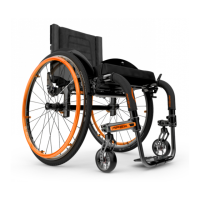9
User
Manual
a) Always use anti-tippers if you are not a skilled rider.
b) Always use anti-tippers each time you modify or adjust your
wheelchair. Any change may make it easier to tip backward. .
c) Use anti-tippers until you adapt to the change, and are sure
that you are not at risk to tip over.
8.1.2 Environmental Conditions
The APEX was designed to be used on hard and plane
surfaces like asphalt, concrete, and indoor hard flooring or
carpeting.
DO NOT operate on roads, streets or highways.
Beware that the maneuverability of the wheelchair is
significantly affected by different outside conditions such as
sand, mud, rain, snow and rough surfaces. If you use your
wheelchair in these conditions, it is recommended that you have
it frequently serviced.
Be careful when using your wheelchair on wet or slippery
surfaces.
Exposure to water or excessive moisture can be damaging and
may even cause the wheelchair to corrode over the long-term.
DO NOT leave your wheelchair in humid environments such as
the bathroom (e.g. while taking a shower). Store the wheelchair
in a dry and cool location. The wheel chair should be stored
away from a direct exposure to sunlight. If the wheelchair is
wet, dry all parts with a cloth before storing it.
DO NOT use your wheelchair in the shower, pool, or other
water situations.
8.1.3 Caregivers
• NEVER use removable parts (e.g. armrests, footrests) to
push the wheelchair and never use them to lift the wheelchair
occupied since they could cause injuries or damage.
• Ensure that the wheelchair is equipped with push handles and
that its grips are securely in place.
• Turn anti-tipping devices upwards or remove them to avoid
tripping.
• Should you need to leave the wheelchair user unattended,
engage the wheel locks and place the anti-tipping devices
back in the downward position.
• Ask an experienced caregiver to explain safe assistance
methods to you.
• Ensure ongoing communication between you and the
wheelchair user as to avoid any kind of confusion.
• Maintain proper posture to tilt or lift the wheelchair; keep your
back straight and bend at the knees.
• Instruct the wheelchair user to lean his/her back when you are
tilting the wheelchair.
8.2 Riding your wheelchair
8.2.0 In order to reduce the risk of a tip-over,
you should:
1. CONSULT your doctor, nurse or therapist to find out what
axle and caster position and other chair configuration options
are best for you.
2. CONSULT your authorized Motion Composites dealer
BEFORE you modify or adjust your wheelchair. Often, an
adjustment you wish to make can be offset by another
that you have not considered. For example, you may want
to adjust the back angle rearward, which will increase
the likelihood of a rear tip-over. You might not think you
could counteract this tendency by moving the rear wheels
backward. Your authorized Motion Composites dealer will be
able to give you expert, personalized advice in such matters.
3. A LWAYS have someone assist you until you learn your
chair’s balance points and are completely comfortable in
your ability to operate your chair under all conditions so as to
avoid tip-overs.
4. A LWAYS use anti-tippers.
If you ignore these Warnings, you may fall, tip over or lose
control of the wheelchair and seriously injure yourself or others
or damage the wheelchair.
8.2.1 Balance point
It is important to begin by learning all of the specific
characteristics of your wheelchair. Ask a health professional
to explain them to you. Carrying a backpack will affect the
balance point of your wheelchair. Be aware of resulting
handling factors in relation to your body position, posture or
weight distribution. The center of gravity is affected by the
angle of the wheelchair on a ramp or slope. This can be felt in
forward and backward as well as side to side movements.
Make sure to review the different riding techniques prior to
using the wheelchair. Use anti-tippers until you are skilled at
riding your wheelchair in any situation.
8.2.2 Wheelies
DO NOT attempt to perform a wheelie in
your wheelchair because of the dangerous
nature of this kind of maneuver. Motion
Composites recognizes that some
wheelchair users will ignore this Warning. If
you should choose to ignore this Warning,
you should follow these steps to help learn
to do a “wheelie” as safely as possible.
NEVER attempt to learn to do a wheelie without first consulting
your health care advisor. NEVER attempt to learn to do a
wheelie without an assistant that can catch you if you should
happen to start to fall. NEVER attempt to learn to do a wheelie
unless you are a skilled rider on this chair.
Motion Composites always recommend using the anti-tippers
at all-time unless they need to be removed to go up or down a
curb/step. Anti-tippers should be reinstalled once the curb/step
is cleared.
8.2.3 Transferring
Rotate the front casters forward to
enhance stability.
Place the wheelchair as close to your
transfer location as possible. Engage wheel
locks. Position yourself as far back as
possible when transferring weight to reduce
risk of tipping forward. If you have good
upper body strength, balance and agility, you may be able to
perform transfers independently.
Rotate or remove footrests if at all possible as to avoid putting
weight on them. If possible, make use of a transfer board.
Always ask a healthcare provider to learn safe transfer
methods.
Always ask a healthcare provider to learn safe transfer
methods.
For safety reason, user should always reduce to the
minimum the transfer distance.
DO NOT sit or transfer into the wheelchair unless it is fully
open and the seat frame rails are fully seated into the
receivers.
DO NOT use the footplate as a platform when getting in or out
of the wheelchair or to reach for an object.

